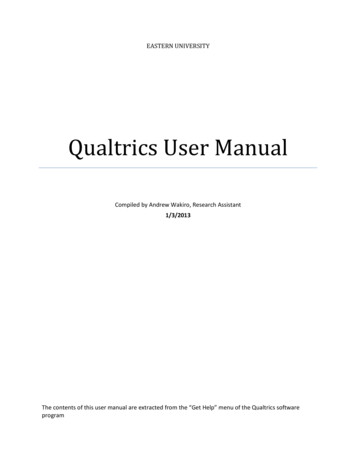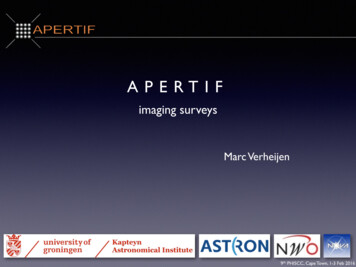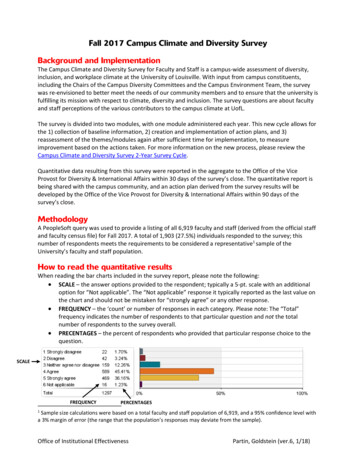
Transcription
www.ijcrt.org 2018 IJCRT Volume 6, Issue 2 April 2018 ISSN: 2320-2882A Survey Paper On The Comparison Of NOSQLEngines (Mongo dB vs. Cassandra) Using Spark1Mounica.B1, Kokila.N 2,Butti Pavithra 3, Tejaswini.V 4Senior.Asst. Professor, Department of Information Science Engineering, New Horizon College of Engineering2,3,4Student, Dept. Of ISE, New Horizon College of Engineering, Bangalore, IndiaAbstract-Relational Database has been used for data storage, recovery and management, as there is need for scalability andperformance, another system like NoSQL technologies are integrated. While most of the researches are focused on theperformance and there has been no focus on the classification for NoSQL databases where databases are compared with eachother .To overcome this, we examine and create a brief and up-to-date evaluation of NoSQL engines (Mongo dB vs.Cassandra), recognizing their most valuable use cases and the quality attributes that each of them is mostly suited to.Keyword-Big data, Mongo dB, Cassandra, Spark, NoSQL.1. Introduction.Big data is a term that describes the large volume of data for both structured and unstructured, but it’s not concerned about theamount of data, it’s about the organizations that do with the data matters [1]. Big data can be analyzed for understandings thatlead to better decisions and strategic moves.Definition of Big data as four V’s:Volume: Organizations contains a collection of data from many sources, such as business transactions, social media andinformation from sensor or machines.Velocity: Data streams at high speed and must be distributed within timely manner, for e.g.: the social media messages andcredit card transaction details.Variety: Data sources are extremely heterogeneous. Data is obtained in all types of formats like structured and unstructuredsuch as documents, email, video, audio and financial transactions. [1, 2]Hadoop is the foundation for big data applications, and it is the basic platform for big data. Spark is a framework whichexploits in-memory abilities to deliver fast (almost 100 times faster than Hadoop). Thus, Spark is mostly used in the world ofbig data, and mainly for fast processing. Spark is an open source framework that processes big data with speed and simplicity.Spark can be used in Hadoop environment. It is developed at the University of California and then later offered to theFoundation. The purpose of Spark is, it offers the developers with an application framework that works at a centered datastructure. Spark is very powerful and has the initial ability to process huge amount of data in a short period of time, whichprovides excellent performance. Thus, Spark makes it a lot faster than compared to Hadoop [4].SPARK ECOSYSTEM:There are 6 components in Apache Spark Ecosystem which are: Spark Core Spark SQL, Spark Streaming, Spark MLlib, Spark GraphX, SparkR.IJCRT1812689International Journal of Creative Research Thoughts (IJCRT) www.ijcrt.org424
www.ijcrt.org 2018 IJCRT Volume 6, Issue 2 April 2018 ISSN: 2320-2882SPARK CORE:The functionalities of Apache Spark are built on the top of Spark Core. It delivers speedily with the help of Spark. It isresponsible for basic I/O functionalities, scheduling and monitoring the jobs on spark clusters. It help in fault recovery, itovercome the problem of Map Reduce by using in-memory computation.Spark Core is embedded with RDD (Resilient distributed dataset). While when we reuse data in computing systems likeHadoop Map Reduce. It needs to store the data in an intermediate storage. Thus, the speed of computation reduces. Thus, RDDovercomes the limitation with the help of fault tolerant [6].Spark SQL:Spark SQL is one of the Spark Ecosystem components. Spark SQL is used when the data is large, to perform structured dataanalysis. By using the component, we get information about the data structure and their computations. With the help of thisinformation we can perform extra optimization, where an output can be computed on the engine. The extraction and mergingof dataset can be performed easily with the help of Spark SQL. So that. It acts as a distributed SQL Query. It can also accessstructure and semi structure.Spark Streaming:It is a light weighted component of Spark Ecosystem. With the help of it developers can perform batch processing andstreaming. The real time data can be processed, by using a continuous stream of input data’s.MLIB:It is one of the most important components of Spark Ecosystem. It’s a scalable machine learning library; it obtains bothHigh-quality algorithms as well as intense Speed. It supports API’s like Java, Scala, and Python [6].GraphX:GraphX is used in spark as graphs and graphical computations; Spark has “Graph Computation Engine”, called GraphX. It iswidely used as graph processing tools.SparkR:R is the best for statistical performance. R has already been integrated in Hadoop. It is a package for R language that enablesR users to influence the power of Spark from R.WHY Spark:Apache Spark has been recognized to overcome Hadoop in various features, which possibly explains why spark is important.One of the main reasons for this is its processing speed. It also offers faster processing for about 100 times than Hadoop forthe same amount of data. It also uses expressively few properties as Hadoop, by making it cost-effective. Spark also has theupper hand in terms of compatibility with resource management. It is also known to run with Hadoop, just like Map Reduce.Apache Spark can also work with resource manager like YARN or Mesos.It has APIs of several languages such as Scala, Java and Python. It is simple to write the user-defined functions.NOSQL:NOSQL systems are Non-Relational database systems that are distributed and are understood as Not Only SQL.NOSQL databases are known to provide easier scalability, storage flexibility, and greater data manipulation and performanceimprovement.The types of NOSQL database systems are: Wide-column stores, Graph databases and Document stores are identified mostcommonly1. Mongo DB,IJCRT1812689International Journal of Creative Research Thoughts (IJCRT) www.ijcrt.org425
www.ijcrt.org2.3.4.5.6. 2018 IJCRT Volume 6, Issue 2 April 2018 ISSN: 2320-2882Cassandra,Dynamo DB andCouch,Neo4j,Riakare the more popular NOSQL databases used commonly in today’s environment. From the above types of NoSQL databaseswe have chosen Mongo DB and Cassandra [5,8] to check the performance between them both.Mongo dB:MongoDB is an open source database which uses document-oriented data model. Instead of using tables and rows likerelational database, Mongo DB is developed on the “architecture of collections” and “documents”. Here it also holds a set ofdocuments and functions as similar as relational database tables. It also supports “dynamic schema design”, It can have acollections of different fields and structures. BSON are used for Document storage and data swapping format, the binaryrepresentation of JSON- as documents. “Automatic sharing” the data in a collection to be distributed across multiple systemsfor horizontal scalabilities data sizes increase.While inserting the data into mongodb, it is faster, than Cassandra ,but while retrieving the data it take a lot of time ,as thedata is been dumped into the mongo dB as a document format[3,5,9].The characteristics are:1.2.3.4.5.6.7.It provides Schema-free.It supports for high performance.Replication and fail sat high availabilityAuto ShadingEasy readabilityMaster-slave modelCP on CAPGood for:1.2.3.4.5.RDBMS replacement for web applicationsSemi-structured content managementReal-time analyticsHigh-speed logging, caching and high scalabilityWeb 2.0, Media, SAAS, GamingNot good for:1.2.High transactional systemsApplications with traditional database requirements such as foreign key constraintsUsage Case: Craigslist, FoursquareCassandra:Cassandra is also known as a NoSQL database it is extremely scalable and big data prepared. it is also a distributed databasei.e. highly fault tolerant without any single point of failure. It is also known as high performance database. Cassandra wasbasically developed at Face book as a mixture of the Cassandra is mainly used to store a large amount of data very quickly. Asmany online applications have database requirements that overdo the skills of a relational databases. It is a huge “Open sourcenon-relational database” .which offers a continuous availability and easy data across multiple data centers and cloud,operational simplicity.Wide-column store based on ideas of Big Table and Dynamo DBCassandra has a single-row read performance as long as eventual consistency semantics are enough for the use-case.If data is stored as columns in Cassandra supports range scans. Cassandra supports secondary indexes on columns where thecolumn name is known.The Aggregations must be provided by the clients, while they are not accepted by the Cassandra nodes. When the aggregationextends multiple rows, Random Partitioning is very difficult for the client. Thus Storm or Hadoop are recommended foraggregations [3, 5, 9].Characteristics:1.High availabilityIJCRT1812689International Journal of Creative Research Thoughts (IJCRT) www.ijcrt.org426
www.ijcrt.org2.3.4.5.6.7. 2018 IJCRT Volume 6, Issue 2 April 2018 ISSN: 2320-2882Incremental scalabilityEventually consistentTrade-offs between consistency and latencyMinimal administrationNo SPF (Single point of failure) – all nodes are the same in CassandraAP on CAPGood for:1.2.3.4.Simple setup, maintenance codeFast random read/writeFlexible parsing/wide column requirementNo multiple secondary index neededNot good for:1.2.3.4.5.6.7.Secondary indexRelational dataTransactional operations (Rollback, Commit)Primary & Financial recordStringent and authorization needed on dataDynamic queries/searching on column dataLow latencyUsage Case: Twitter, Travel portalExperimental Framework:Our comparisons between the two databases include:1.2.3.Insertion of data into the database.Retrieval of the data from the database.Deletion of the data.The performance of both the NoSQL Databases can be compared with the help of the duration taken by them to perform theinsert and retrieve.FIG1:(fig1)The above image shows us the duration of time taken by Mongo dB to insert and retrieve the data.FIG2:(fig 2)The above image shows us the duration of time taken by the Cassandra for insert and retrieves of the data. Theperformance of the retrieval and insert id represented in the graphical form.Insert to the database:IJCRT1812689International Journal of Creative Research Thoughts (IJCRT) www.ijcrt.org427
www.ijcrt.org 2018 IJCRT Volume 6, Issue 2 April 2018 ISSN: 2320-2882The above graph is plotted based on insertion of data in MongoDB and Cassandra.Retrieval of data:The above graph is plotted based on the retrieval of data in MongoDB and Cassandra.CONCLUSION:NoSQL consist of multiple types of databases but for this paper we have chosen MongoDB and Cassandra. Here we check theperformance between Mongodb and Cassandra ,as the performance between them is been obtain through a graphicalrepresentation, With the help of this paper ,it proves that Cassandra works faster than Mongo DB in clustered memory and italso helps in fast retrieval and insertions of multiple data. Even Mongo DB is fast in retrieval and insertion in single memory.Thus ,this paper make us understand that both the NoSql databases are best in their performance in their own type, as they bothhave their own advantages as well as 2.13.14.Dhole Poonam B, GunjalBaisa L, “Survey Paper on Traditional Hadoop and Pipelined Map Reduce” International Journal ofComputational Engineering Research Vol, 03 Issue, 12 Labrinidis A, Jagadish H. Challenges and opportunities with big data. Proceedings of the VLDB Endowment, 2012, 5(12):2032–2033Google ScholarA performance comparison of SQL and NoSQL databasesYishan Li and SathiamoorthyManoharan Department of ComputerScience University of Auckland New Zealand.B. Tudorica and C. Bucur, “A comparison between several NoSQLdatabases with comments and notes,” in RoedunetInternational Conference (RoEduNet), 2011 10th, june 2011, pp. 1 –5.M. Zaharia, M. Chowdhury, M. J. Franklin, S. Shenker,I. Stoica, "Spark: cluster computing with working sets", Proceedings of the 2nd USENIX conference on Hot topics in cloudcomputing, 2010.M. Zaharia, M. Chowdhury, M. J. Franklin, S. Shenker, I. Stoica, "Spark: cluster computing with working sets", Proceedingsof the 2nd USENIX conference on Hot topics in cloud computing, ://databricks.com/spark/aboutL. Bonnet, A. Laurent, M. Sala, B. Laurent, N. Sicard, "Reduce you say: What nosql can do for data aggregation and bi inlarge repositories", Database and Expert Systems Applications (DEXA) 2011 22nd International Workshop on, pp. ig Data Anonymization with Spark Yavuz Department of Computer Engineering Faculty of Engineering, Gazi UniversityAnkara, Turkey Seref Department of Computer Engineering Faculty of Engineering, Gazi University Ankara, TurkeyS. Sakr, A. Liu, D. Batista, and M. Alomari, “A survey of large scaleData management approaches in cloud environments,” Communications Surveys Tutorials, IEEE, vol. 13, no. 3, pp. 311–336,2011.Handling Big Data Using NoSQLJagdevBhogal Fac. of Comput., Eng. & the Built Environ. Birmingham City Univ.,Birmingham, UK.ImranChoksi, Fac. of Comput., Eng. & the Built Environ, Birmingham City Univ., Birmingham, UK.Clustering of Datasets Using K-Means Algorithm in SPARK, International Journal of Innovative Research in Computer andCommunication Engineering, Subiksha N 1, Pallavi R Reddy1, Mounica B2 Vol. 5.Inclusive Analysis of Incomplete Datasets Using IkNN Search International Journal of Innovative Research in Computer andCommunication Engineering Vol.5, Baswaraju Swathi1 , Sonia Singh2 , Sujithra K S 3IJCRT1812689International Journal of Creative Research Thoughts (IJCRT) www.ijcrt.org428
Keyword-Big data, Mongo dB, Cassandra, Spark, NoSQL. 1. Introduction. Big data is a term that describes the large volume of data for both structured and unstructured, but it's not concerned about the amount of data, it's about the organizations that do with the data matters [1]. Big data can be analyzed for understandings that











